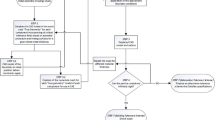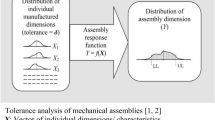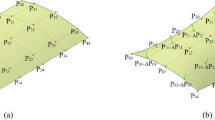Abstract
Based on the manufacturing history chain, a component’s macro residual stress is introduced to the subsequent assembly model. In the simulated method, the simulation cost is saved via mapping the bulk stress profile directly to the component compared to our previous study. It thus facilitates the finite element analysis (FEA) which takes the component location in blank and the thickness of blank as two influence parameters. The methodology is proved to be feasible by the validation experiment designed for a typical assembly structure from the aerospace industry. The results show that the bulk stress originating from material preparation affects the downstream large-scale assembly deformation. The investigation of this research helps systematically to improve compliant assembly precision.
Similar content being viewed by others
References
Withers P J, Bhadeshia H K D H. Residual stress. Part 2. Nature and origins [J]. Materials Science and Technology, 2001, 17(4): 366–375.
Liu S C, Hu S J. Variation simulation for deformable sheet metal assemblies using finite element methods [J]. Journal of Manufacturing Science and Engineering, 1997, 119(3): 368–374.
Camelio J, Hu S J, Ceglarek D. Modeling variation propagation of multi-station assembly systems with compliant parts [J]. Journal of Mechanical Design, 2003, 125(4): 673–681.
Hu M, Lin Z Q, Lai X M, et al. Simulation and analysis of assembly processes considering compliant, non-ideal parts and tooling variations [J]. International Journal of Machine Tools and Manufacture, 2001, 41(15): 2233–2243.
Cai W, Hu S J, Yuan J X. Deformable sheet metal fixturing: Principles, algorithms, and simulations [J]. Journal of Manufacturing Science and Engineering, 1996, 118(3): 318–324.
Zhang L N, Wang H, Li S H, et al. A quantitative modeling and decoupling method for assembly deformation analysis considering residual stress from manufacturing process [J]. Journal of Aerospace Engineering, 2014. DOI: 10.1061/(ASCE)AS.1943-5525.0000400, 0401.073 (published online).
Nervi S. A mathematical model for the estimation of the effects of residual stresses in aluminum plates [D]. Saint Louis, Missouri, USA: Department of Mechanical and Aerospace Engineering, Washington University, 2005.
Robinson J S, Tanner D A, Truman C E, et al. Measurement and prediction of machining induced redistribution of residual stress in the aluminum alloy 7449 [J]. Experimental Mechanics, 2011, 51(6): 981–993.
Liao Kai, Wu Yun-xin, Gong Hai, et al. Prediction and measurement of quenching-prestretching stress in aluminum alloy thick plate [J]. The Chinese Journal of Nonferrous Metals, 2010, 20(10): 1901–1906 (in Chinese).
Gong H, Wu Y X, Liao K. Prediction model of residual stress field in aluminum alloy plate [J]. Journal of Central South University of Technology, 2011, 18(2): 285–289.
Wu Yun-xin, Gong Hai, Liao Kai. Evaluation model of residual stress field of pre-stretched aluminum alloy plate [J]. Journal of South China University of Technology: Natural Science Edition, 2011, 39(1): 90–94 (in Chinese).
Sim W M. Challenges of residual stress and part distortion in the civil airframe industry [EB/OL](2014-03-08). http: //www.transport-research.info / web / projects/project details.cfm?id=11303.
Young K A. Machining-induced residual stress and distortion of thin parts [D]. Saint Louis, Missouri, USA: Department of Mechanical Engineering, Washington University, 2005.
Author information
Authors and Affiliations
Corresponding author
Additional information
Foundation item: the National Basic Research Program (973) of China (No. 2010CB731703), and the National Natural Science Foundation of China (No. 51275308)
Rights and permissions
About this article
Cite this article
Zhang, Ln., Wang, H. & Li, Sh. Compliant assembly modeling and deformation analysis considering macro residual stress in engineering component. J. Shanghai Jiaotong Univ. (Sci.) 20, 641–648 (2015). https://doi.org/10.1007/s12204-015-1671-2
Received:
Published:
Issue Date:
DOI: https://doi.org/10.1007/s12204-015-1671-2




